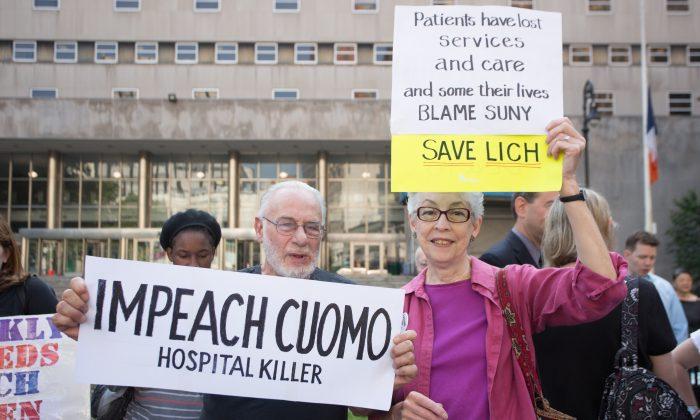NEW YORK—Community members called on city and state officials to save the Long Island College Hospital (LICH) outside the Kings County Supreme Court in a heated rally before a hearing Tuesday morning.
“We think this is our last chance to come and fight,” said Bob Pepper. He and his wife Brenda have been residents of Brooklyn Heights since 1966, and live just around the corner from the historic hospital.
Prior to hearing the motion, Supreme Court Justice Johnny Lee Baynes asked the attorneys to come to a settlement. Fortis Property Group, which is now in talks to develop the property, did not agree to provide the same proposal as the previous bidder Peebles Corp., so no settlement was made.
The State University of New York Downstate (SUNY) has been trying to sell the historic hospital, and had reissued its request for proposals (RFP) to rank developers providing healthcare with more points, based on a settlement with community groups.
The community groups had made concessions in settling with SUNY for an RFP that would rank hospitals higher. “We traded justice ... for a process,” attorney Jim Walden said.
But the process was not honored, according to Walden’s argument in court.
Now the community groups are arguing SUNY and the State Department of Health (DOH) manipulated the ranking process.
A total of 18 evaluators were chosen by both SUNY and the community groups to rank the nine developer bids. Full service hospitals were eligible for more points; lack of emergency services and an intensive care unit made the proposal eligible for a point reduction.
Arguments
DOH and SUNY lawyers argued that the intention of using the evaluators was to allow for subjective decisions. Meaning: a full service hospital was eligible for more points, but the evaluator does not necessarily need to award extra points, especially if they doubt the developer’s ability or intention to deliver.
One of the evaluators, Walden pointed out, gave zero points to the four out of nine bidders who proposed a hospital, but gave Fortis a full score of 70 points. Fortis, which won the original RFP and ranked third in the redo, proposed a free-standing clinic and emergency services.
Several other evaluators ranked the bidders similarly, Walden said, giving more points to Fortis than to a full service hospital. “Either their scores need to be disqualified or this RFP needs to start over.”
“What Mr. Walden asked for could be done by a computer,” argued attorney Nicole Gueron, representing DOH.






Friends Read Free